The iPhone 5 Review
by Anand Lal Shimpi, Brian Klug & Vivek Gowri on October 16, 2012 11:33 AM EST- Posted in
- Smartphones
- Apple
- Mobile
- iPhone 5
GPU Analysis/Performance
Section by Anand Shimpi
Understanding the A6's GPU architecture is a walk in the park compared to what we had to do to get a high level understanding of Swift. The die photos give us a clear indication of the number of GPU cores and the width of the memory interface, while the performance and timing of release fill in the rest of the blanks. Apple has not abandoned driving GPU performance on its smartphones and increased the GPU compute horsepower by 2x. Rather than double up GPU core count, Apple adds a third PowerVR SGX 543 core and runs the three at a higher frequency than in the A5. The result is roughly the same graphics horsepower as the four-core PowerVR SGX 543MP4 in Apple's A5X, but with a smaller die footprint.
As a recap, Imagination Technologies' PowerVR SGX543 GPU core features four USSE2 pipes. Each pipe has a 4-way vector ALU that can crank out 4 multiply-adds per clock, which works out to be 16 MADs per clock or 32 FLOPS. Imagination lets the customer stick multiple 543 cores together, which scales compute performance linearly.
SoC die size however dictates memory interface width, and it's clear that the A6 is significantly smaller in that department than the A5X, which is where we see the only tradeoff in GPU performance: the A6 maintains a 64-bit LPDDR2 interface compared to the 128-bit LPDDR2 interface in the A5X. The tradeoff makes sense given that the A5X has to drive 4.3x the number of pixels that the A6 has to drive in the iPhone 5. At high resolutions, GPU performance quickly becomes memory bandwidth bound. Fortunately for iPhone 5 users, the A6's 64-bit LPDDR2 interface is a good match for the comparatively low 1136 x 640 display resolution. The end result is 3D performance that looks a lot like the new iPad, but in a phone:
| Mobile SoC GPU Comparison | |||||||||||
| Adreno 225 | PowerVR SGX 540 | PowerVR SGX 543MP2 | PowerVR SGX 543MP3 | PowerVR SGX 543MP4 | Mali-400 MP4 | Tegra 3 | |||||
| SIMD Name | - | USSE | USSE2 | USSE2 | USSE2 | Core | Core | ||||
| # of SIMDs | 8 | 4 | 8 | 12 | 16 | 4 + 1 | 12 | ||||
| MADs per SIMD | 4 | 2 | 4 | 4 | 4 | 4 / 2 | 1 | ||||
| Total MADs | 32 | 8 | 32 | 48 | 64 | 18 | 12 | ||||
| GFLOPS @ 200MHz | 12.8 GFLOPS | 3.2 GFLOPS | 12.8 GFLOPS | 19.2 GFLOPS | 25.6 GFLOPS | 7.2 GFLOPS | 4.8 GFLOPS | ||||
We ran through the full GLBenchmark 2.5 suite to get a good idea of GPU performance. The results below are largely unchanged from our iPhone 5 Performance Preview, with the addition of the Motorola RAZR i and RAZR M. I also re-ran the iPad results on iOS 6, although I didn't see major changes there.
We'll start out with the raw theoretical numbers beginning with fill rate:
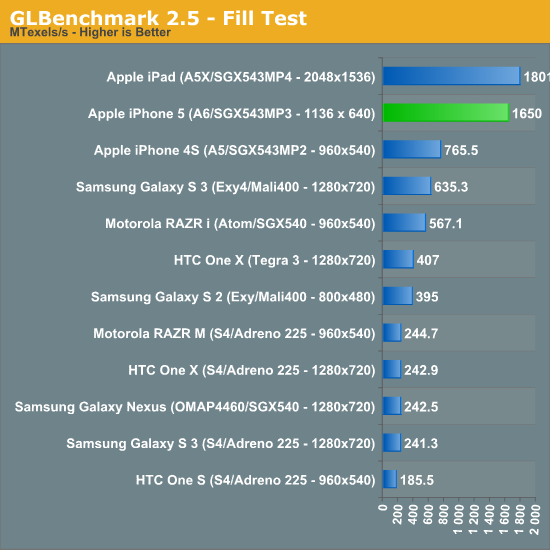
The iPhone 5 nips at the heels of the 3rd generation iPad here, at 1.65GTexels/s. The performance advantage over the iPhone 4S is more than double, and even the Galaxy S 3 can't come close.
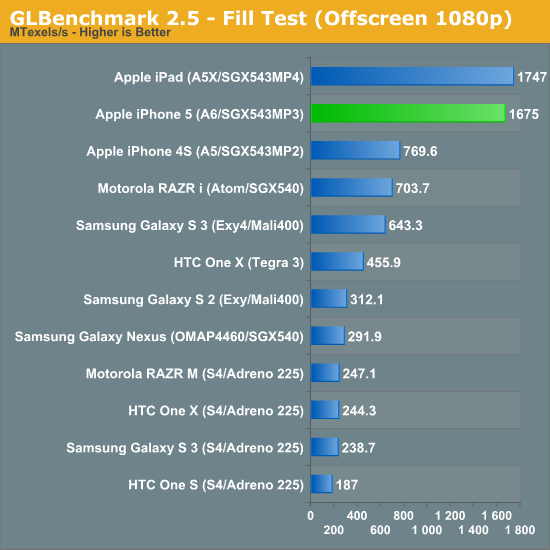
Triangle throughput is similarly strong:

Take resolution into account and the iPhone 5 is actually faster than the new iPad, but normalize for resolution using GLBenchmark's offscreen mode and the A5X and A6 look identical:
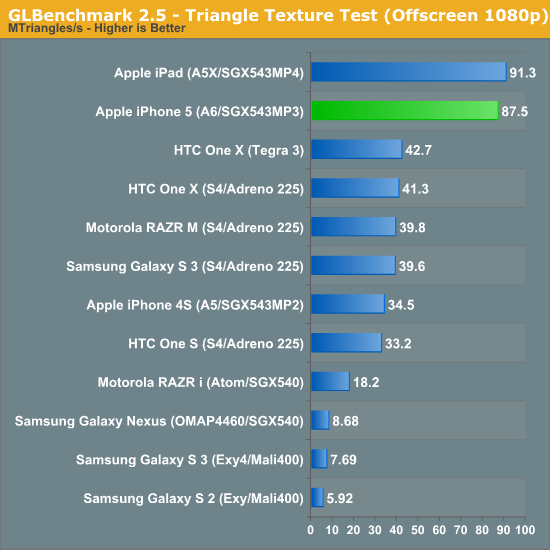
The fragment lit texture test does very well on the iPhone 5, once again when you take into account the much lower resolution of the 5's display performance is significantly better than on the iPad:
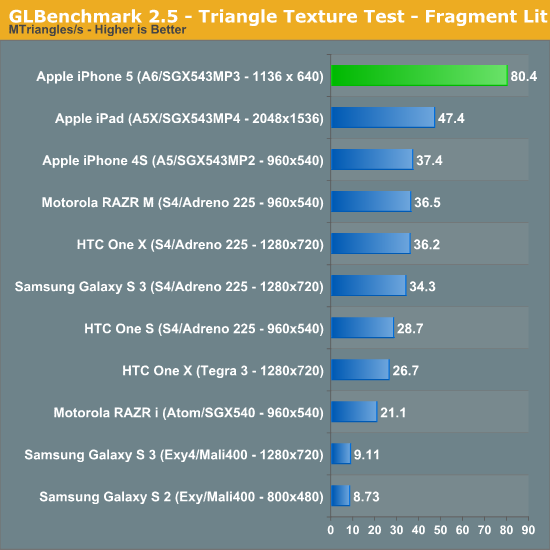
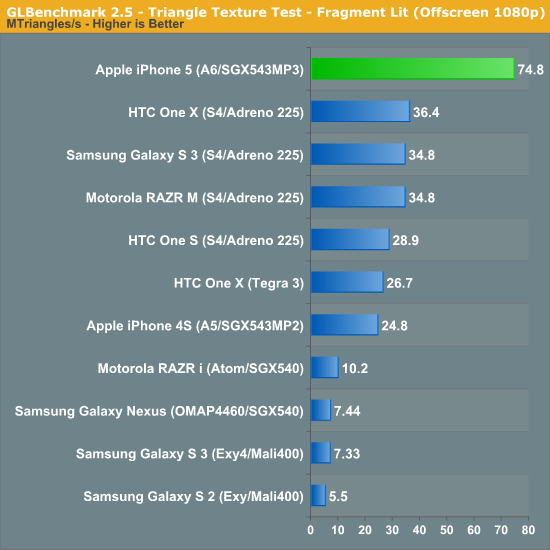

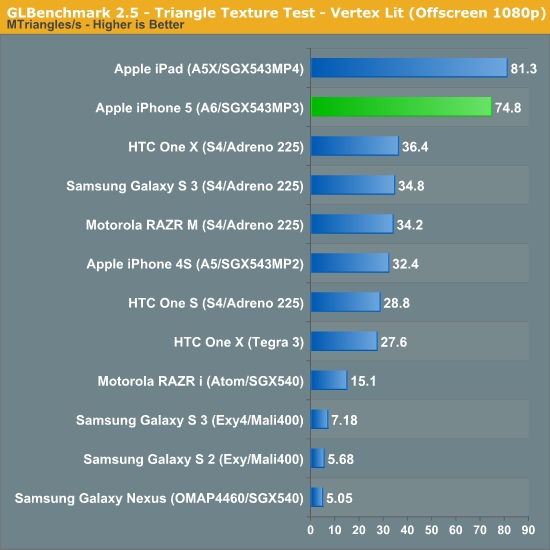
The next set of results are the gameplay simulation tests, which attempt to give you an idea of what game performance based on Kishonti's engine would look like. These tests tend to be compute monsters, so they'll make a great stress test for the iPhone 5's new GPU:
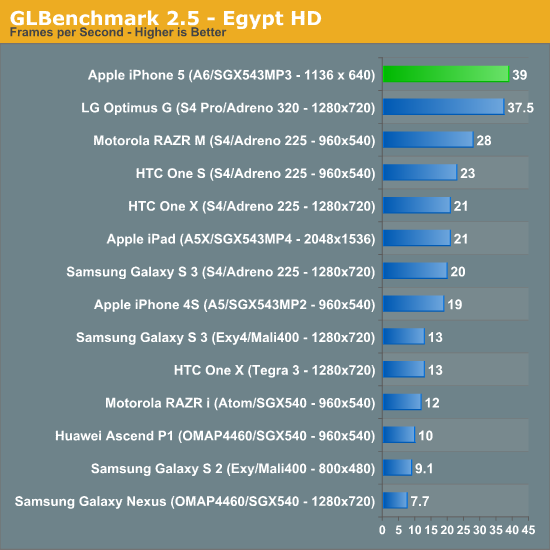
Egypt HD was the great equalizer when we first met it, but the iPhone 5 does very well here. The biggest surprise however is just how well the Qualcomm Snapdragon S4 Pro with Adreno 320 GPU does by comparison. LG's Optimus G, a device Brian flew to Seoul, South Korea to benchmark, is hot on the heels of the new iPhone.
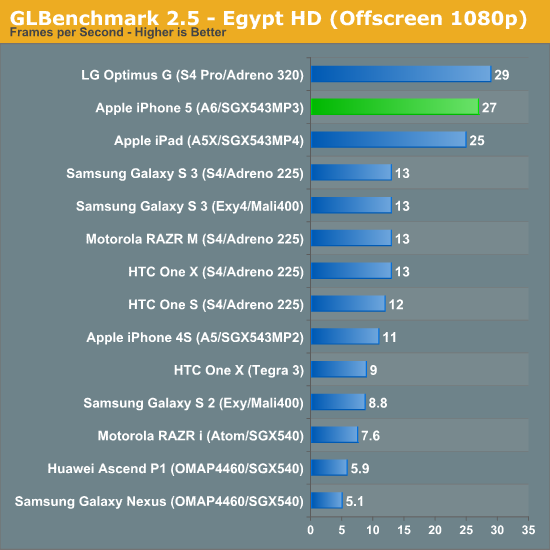
When we run everything at 1080p the iPhone 5 looks a lot like the new iPad, and is about 2x the performance of the Galaxy S 3. Here, LG's Optimus G actually outperforms the iPhone 5! It looks like Qualcomm's Adreno 320 is quite competent in a phone. Note just how bad Intel's Atom Z2460 is, the PowerVR SGX 540 is simply unacceptable for a modern high-end SoC. I hope Intel's slow warming up to integrating fast GPUs on die doesn't plague its mobile SoC lineup for much longer.
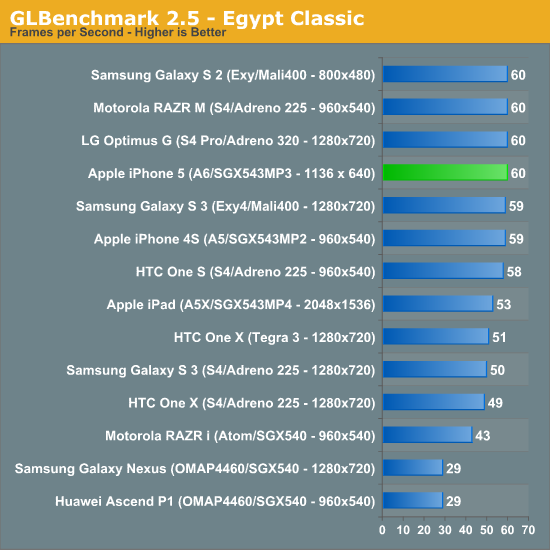
The Egypt classic tests are much lighter workloads and are likely a good indication of the type of performance you can expect from many games today available on the app store. At its native resolution, the iPhone 5 has no problems hitting the 60 fps vsync limit.
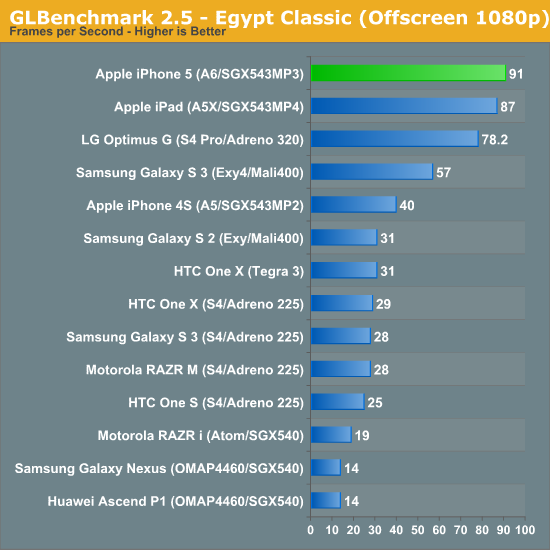
Remove vsync, render at 1080p and you see what the GPUs can really do. Here the iPhone 5 pulls ahead of the Adreno 320 based LG Optimus G and even slightly ahead of the new iPad.
Once again, looking at GLBenchmark's on-screen and offscreen Egypt tests we can get a good idea of how the iPhone 5 measures up to Apple's claims of 2x the GPU performance of the iPhone 4S:
Removing the clearly vsync limited result from the on-screen Egypt Classic test, the iPhone 5 performs about 2.26x the speed of the 4S. If we include that result in the average you're still looking at a 1.95x average. As we've seen in the past, these gains don't typically translate into dramatically higher frame rates in games, but games with better visual quality instead.











276 Comments
View All Comments
Zink - Wednesday, October 17, 2012 - link
That's would be light enough to float.manders2600 - Wednesday, October 17, 2012 - link
It would be really nice to see some of these benchmarks next to an Android device running Jellybean.From my personal experience with the Galaxy Nexus, all of the benchmarks run in this article improve dramatically (many by more than 50%) with that OS version.
I'm really curious to see what a comparison between the performance of an S4 (Krait) and an A6 would be in that situation, since so much of the CPU tests are impacted by OS.
manders2600 - Wednesday, October 17, 2012 - link
But great read, though!. . . sorry, forgot to include that.
Tremendous research went into this, and it is well appreciated.
phillyry - Sunday, October 21, 2012 - link
I agree.I mean it's good that you have the devices on their native OSes but showing them on their upgraded OSes would bee good too 'cause it would add another realistic point of comparison.
cjl - Wednesday, October 17, 2012 - link
In the article, you state:"Which brings us to the next key detail with the anodization process: typically, the thickness of the anodization is half the thickness of the base aluminum. So if you had an aluminum plate that was 1mm thick, post-anodization, you would end up with a 1.5mm thick plate"
You also talk about the pore density in anodizing, and claim that apple has a pore density higher than most.
To put it quite simply, all of this is wrong.
Anodizing creates a layer that is on the order of micrometers thick. How thick the coating is depends on the details of the anodizing process, not on the thickness of the base metal. Most decorative anodized coatings are a few micrometers thick, and as you discussed, it's really not that hard to scratch them. Thicker anodizing, sometimes known as hard anodizing, is possible, and it can be done to thicknesses of 25 micrometers (0.001") or greater - from what I can find, over 100 micrometers is possible. These thicker coatings provide pretty substantial scratch resistance, and significant increases in durability, but they require substantially more process control, and it is more difficult to get a consistent coating. Note that even the thickest of these coatings is around 0.006 inches (150 micrometers) or so, which is far, far less than a 2:1 ratio on the aluminum on which it is applied. Interestingly, this thickest possible coating is about what you speculate is the thickness on the iPhone 5, but given its propensity for scratching, I sincerely doubt this to be the case.
Now for pores. The pore size on anodized aluminum is a few tens of nanometers. There is absolutely no way that you could visibly see this, or any improvement in this from one product to the next. This is 20 times smaller than the smallest wavelength of visible light. Quite simply, you can't possibly see this, and this won't be any different between Apple and any other manufacturer.
That having been said, there are some slight differences in pore structure between coatings. They won't make a significant visible difference (if any at all), but they can make a difference in durability. Specifically, hard anodized coatings (as mentioned above) tend to have thicker walled pores relative to the pore diameter. This again helps increase the wear resistance of hard anodized parts.
TL,DR: The iPhone probably has a really thin anodizing coat (<10 um). The pores are never visible on anodizing. Anodizing can be done, even on very thin aluminum, such that it would be incredibly scratch resistant.
Jaguar36 - Wednesday, October 17, 2012 - link
+1 on this.Not sure where the Vivek got the 2:1 ratio for an anodization thickness, but its nonsense. If you have a 0.25" thick part you're not going to be getting a 0.125" thick anodization. Anodization is usually less than 0.001" thick, and has no relation to the base part thickness.
Cibafsa - Wednesday, October 17, 2012 - link
Whilst Android based device manufacturers do not have to bear the majority of the SOC design/manufacture costs or the OS development costs, they do not share in the iAds/App Store type revenue Apple does.Surely it is Apple that can afford to cut prices to cost or even lower. Perhaps it is the Android manufacturers that have to worry about cheap high end phones.
Will be interesting to see what price point the iPad mini comes in at.
steven75 - Wednesday, October 17, 2012 - link
Most people following this industry are well aware by now that the App Store is run near break-even and iAds were not very successful.Calista - Wednesday, October 17, 2012 - link
A good and through review but I found it a bit too long-winded. An example would be the following example straight from the first page:'All previous iPhones have maintained the same 3.5-inch, 3:2 aspect ratio display. With the rest of the world quickly moving to much larger displays, and with 16:9 the clear aspect ratio of choice, when faced with the decision of modernizing the iPhone platform the choice was obvious.'
It could have been shortened to:
'iPhone 5 moves from the previously used 3.5", 3:2 aspect ration to a 4", 16:9 aspect ratio as common among smartphones of today. They kept roughly the same width while increasing the hight with xx mm. The resolution went from 960x640 to 1136x640."
More information is contained in the rewritten part while at the same time being shorter. Don't forget that this is Anandtech and I assume every single one of your readers are familiar with both the size and resolution of previous iPhones as well as common aspect ratios used on phones.
The same could be said about the design. I'm sure every single one of your readers have held and played with an iPhone 4/4s, and so when comparing to those two you guys could have kept a lot shorter.
phillyry - Sunday, October 21, 2012 - link
Read better as originally posted than as you rewrote it.